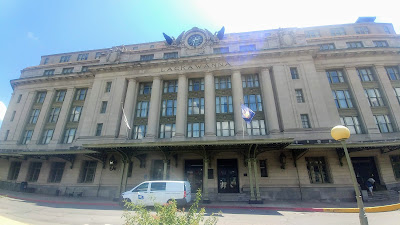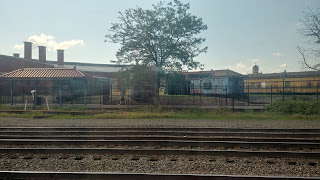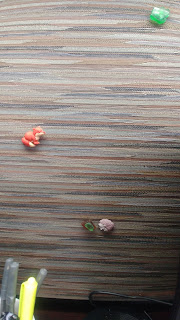After lunch at a cute little café, we walked over to the former Delaware, Lackawanna and Western Railroad station, built in 1908 and closed in 1970. This beautiful French Renaissance-style building with Italian marble and a Tiffany stained-glass skylight is now a Radisson Hotel. We wanted to look at the Grueby Faience art nouveau tiles showing bucolic scenes of the Delaware Water Gap, Budd Lake, and Niagara Falls along the Phoebe Snow line from Hoboken, NJ, to Buffalo, NY. ("Phoebe Snow" was the New Woman dressed in white who prized the clean-burning anthracite coal mined in the Scranton area in rhyming advertisements for the DL&W. We had wanted to visit the Pennsylvania Anthracite Heritage Museum, but it is closed due to COVID and the fact that the underground tour involves spending considerable time squeezed into a very small space.)
Welcome to my Album of Photographs and Memories of Travel, practicing Medicine, culinary Experiments, and other Exploits.
Wednesday, June 30, 2021
Wednesday off the rails, Part 2
Wednesday on the rails, Part 1
Tuesday, June 29, 2021
Tuesday on the river
In case you missed it, here's how we started our vacation, on Monday in the mountains.
On Tuesday Dear Husband slept in while My Awesome Parents (MAP) and I visited the goats, the Stoddartsville Cemetery, and the picnic area an easy 15-minute walk through the woods to the river. Stoddartsville is a cluster of eight homes in the middle of nowhere in the Pocono Mountains. John Stoddart founded a lumber and a grist mill by the Lehigh River in order to attract the business of a canal that was being built--alas, they stopped digging six miles away, so he went bankrupt a few years later.
When we got back, we had to divest ourselves of the ticks that had attached themselves to our clothing. Then it was time to pack lunches and gear so we wouldn’t be late for our river rafting adventure. As it turns out, we needn’t have rushed, as we were good and early for the orientation that didn’t start until after (almost) everyone else had arrived 30 minutes after that. I don't have photos, because we all left our phones in the car.
We rafted a ~3-mile stretch of the Lehigh River that ran through Jim Thorpe, PA. You might have heard of Thorpe (Wa-Tho-Huk or “Bright Path," 1887-1953), a member of the Sauk and Fox tribes who was the first Native American to win (gold) medals at the Olympics—for pentathlon and decathlon in Stockholm, Sweden, in 1912. He was "discovered" at the infamous Pennsylvania Carlisle Industrial Indian School, which has been in the news for finally returning the bodies of some of its students. He excelled in multiple sports in school, as well as professional baseball and football after Stockholm, going on to co-found the NFL. Burt Lancaster even starred in a movie about him in 1951: Jim Thorpe: All American. Did you also know that he was belatedly stripped of his medals in 1913 because he had played semi-pro baseball a couple years before the Olympics? The medals were posthumously returned to his family in 1982, but the IOC has never corrected its statistical records to acknowledge his dominance.Do you know why there’s a town named after Jim Thorpe in northeastern Pennsylvania? After Thorpe died of heart failure in 1953, his gold-digging third wife, tired of waiting for $100,000 to be raised for a big burial and monument in Oklahoma, tried to get him buried in Tulsa. Then she heard that Mauch Chunk and East Mauch Chunk, PA, were looking to drum up business, so she made a deal to have him memorialized there. The two towns merged and changed their name to Jim Thorpe in 1954. His mausoleum stands on dirt from Oklahoma and from Stockholm. His son, Jim Thorpe, Jr., tried to sue the town to return his father’s remains to the tribe in Oklahoma but died before he could find other plaintiffs to join his petition. The case was eventually heard, ruled in the city’s favor “as a museum,” and upheld on appeal; the Supreme Court declined to hear it, so his body remains in a city named for him that he never visited. (As a small consolation, at least it was the name of a Native American man that replaced the previous name(s) from a Delaware language.) There's another biographical movie in the making called Bright Path.
Meanwhile, out on the river, the four of us enjoyed a 3-hour tour with only a little bickering about steering. We had enough collected experience to navigate the class-1 rapids, and no one got wet who didn’t want to. Lunch was eaten sitting on shady grass, but then I made a fateful mistake: I re-applied sunscreen after lunch and immediately before swimming rather than before eating to let it set. It washed right off, and by the time we were changed and heading into Weissport to treat ourselves to ice cream for having been so patient with all the delays for latecomers, poor paddlers, and other rafting companies’ flotillas clogging up the river, my thighs and DH’s arms were turning red. (I had also managed to give myself a bruising rope burn on one lower leg while climbing back into the raft.) We had stupidly left our baseball caps at the cabin, since the expedition’s participant instructions made it sound like tipping out of the raft was a distinct possibility. We should not have been so naïve—or spent so much money on croakies to hold our glasses. To make matters worse, it took three tries to find a store carrying aloe vera. Thankfully we spent most of the next day inside and out of the hot sun.We loaded up on groceries on our way back to the cabin, recuperated, and tried to grill steaks—when the skies opened up. The rain that had been forecast suddenly all came down in about 10 minutes. The steaks were finished on the stovetop, and we ate cherries and cookies while playing Tenzi and Rumy before bed. We spent Wednesday on and off the rails.
Monday, June 28, 2021
Monday in the mountains
We had 5.5 hours to read, cross-stitch, eat the breakfast and lunch we had packed, and even attend a Zoom committee meeting. The conductors were friendly, but our car was never as crowded as they warned it would be. The train stopped in various smaller cities like Greensburg (home of Seton Hill University and reportedly one of the best places in the country to retire), Johnstown (famous for its 1932 flood), Altoona, and little Lewistown. Outside Altoona we drove around the "World Famous Horseshoe Curve, "constructed in the 1850s by Irish laborers who earned $0.25 an hour and worked without power tools, according to the conductor who announced it overhead.
 |
| Here is the view approaching the "World Famous Horseshoe Curve." Click here to see what it has to do with Nazis during World War II. |
In Harrisburg, My Awesome Parents (MAP) picked us up at the train station, and we all drove 2.5 hours to “the party house” in New Jersey to visit for a few hours with my mother’s side of the family. Then it was back in the car for another hour so we could be sure to arrive at our cabin in the Poconos Mountains along the Lehigh River with daylight to spare, since the location was so remote that GPS couldn’t find it. We almost couldn’t find it with the printed directions either, since greenery had grown over the white fence posts that supposedly marked the driveway.
Eventually we got settled in for the night at one of a trio of cabins owned by a local entrepreneur who also runs an event center in a reconstructed barn. The original cabin was built in 1915 to be in a silent movie*, while the cast and crew stayed in the nearby inn, The Maples. You can still see the overgrown foundation of the inn after it burned down under suspicious circumstances. The cabin sleeps two, our cottage sleeps six with a couch bed, and there's a lodge with a screened-in back porch overlooking the river that sleeps four. Next to the gravel parking pad is a murky koi pond where some frogs live as well.
*The silent film, My Partner (1916), has been lost, but online synopses say it was a love quadrangle with a murder, a framing, a wrongful conviction, and--at the last minute--exoneration so the guy can live happily ever after with the girl.
Friday, June 18, 2021
Cupboard Mouse
Editor's Note: This is the epilogue to a longer post about the journey it took to get a desk of my own--and my name on the door!
Tuesday, June 8, 2021
Bread pudding in the microwave
2 slices of bread, cubed into a reusable glass dish
Chopped grape tomatoes, bell pepper, asparagus, etc. (4 tbsp)
Saturday, June 5, 2021
Delayed Gratification...Delivered
Medicine is about a lot of things: service to humanity, life-long learning, ... and delayed gratification. Academia too. How many life experiences or projects have been put off "until I finish the dissertation," "once I land a permanent job," or "after I achieve tenure"? I've been blogging here for about a decade (actually 11 or 12 years, depending on whether you count the place-holding post I put up once I had decided on the name for my blog-to-be). I feel that I know a thing or three about delayed gratification. This is the story of gratification delivered.
Premedical college students study subjects that are not-quite-medicine: biology, genetics, general and organic chemistry, physics (!). Maybe the geneticists, pathologists, and radiologists can more directly apply what they learned in those classes to their final careers, but for most aspiring physicians, those are the lists we have to joust in order to pass the MCAT, in order to go medical school, in order to land a good residency, in order to get a fellowship, in order to become >>duhn-duhn<< AN ATTENDING PHYSICIAN.
In medical school it starts over again with anatomy and physiology, microbiology and immunology, histology and epidemiology, pathology and pharmacology. At the time, these basic science courses seemed so far from the clinic that motivation to hang on to what we were learning was hard to come by. Each exam seemed like just another hoop to jump through in order to get to the promised land of "clinical rotations."
Like many medical schools, mine tried to get us excited for patient contact during the first two years by having us shadow practicing physicians. We didn't really know much in the way of useful knowledge or skills yet, however. While we sat in the corner, observing, it was difficult to look ahead to realize what use anatomical landmarks would be for the musculoskeletal physical exam, or that a significant portion of general medical practice involves diagnosing and treating infectious diseases. (I wish I had studied harder in microbio, and immunology really only made sense after we had finished the class.)
I of course chose a path less traveled that simultaneously made this problem of delayed gratification harder and easier. Pursuing an MD-PhD added 8 years to my medical training. It became harder to wear the label "student" the further into my 30s I got. (Don't get me started on the short white med student jacket.) However, the other discipline(s) I was learning--academic history, body scholarship, interdisciplinary science studies, medical humanities--also allowed me do the thing I was studying. I've been a practicing historian since I delivered my first conference paper in my second semester grad school, just over 15 years ago. Not only did I co-author a monograph at MIT Press while still in graduate school, but I am now being asked to organize groups and to edit publications as an early-to-mid-career academic.By contrast, I have only been practicing medicine since I started internship, 5 years ago. And even then, a lot of what I did as a resident was still observing, or "pretending" to be a specialist on various rotations (ID, cardiology, pulmonology, neurology, etc.). Because internal medicine residency produces general internists (and pediatrics residency yields general pediatricians) who have a little bit of knowledge in a lot of different things, I had to wait until my first attending position to actually do full time the thing for which I had been studying: practicing primary care medicine for adults with and without disabilities. Well, part-time, since my faculty position gives me promotional credit for my medical humanities scholarship but not the protected time in which to do it. I grew tired of squeezing my scholarship into nights, weekends, and vacations, so I took a pay cut to get to do it all of those times and also one day during the work week.
The waiting "to arrive" wasn't over with graduation from residency a year ago today, because we still had 3 weeks of service left before the end of our contracts. And I waited 2 months to start my job because I wanted a break from 20 years of continuous higher education to relax and travel (::sigh:: pandemic). And even when I did start at the beginning of September, I still felt like a resident, because my attending credentials had not been entered in the computer system, so I couldn't do my own billing and had to sign my notes over to a colleague for 2 weeks. And for 2 months I was still studying (for the second of 2 board exams).
After I passed my boards, I finally felt like I might have arrived. Except that no one had made provisions for me to have an office, or even a desk in a shared space, so I squatted in empty conference rooms or used one of the fellows' shared desks. (When I pointed this out rather piquedly to the senior attending who had taken over the computer I was using while I was in clinic because his was farther down the hallway, he retorted, "Do you have a job? Have you been receiving a paycheck all this time?" Yes and yes, on the very last day of the month, thank you for reminding me how precarious it was to go 3 months without income last summer.)
Other milestones have been delayed. Dear Husband and I have been trying to try to buy a house almost since we moved to Pittsburgh. We had planned to find a home equidistant between our places of employment between the first and second year of residency, but it took him all that time to find a job. Then we promised ourselves we would buy after five years of renting, but the housing market was too hot for us this spring. And I've been dreaming of a Greek second honeymoon to celebrate 15 years of marriage for at least 2 years (::sigh:: pandemic).
Nevertheless, things are looking up. I am no longer studying in all of my free time, now using it to work on a variety of projects (including TeachingRounds, the ultimate study project). With some promotions and retirements, I finally have my own desk (in a shared space). My name is even on the door! The backboard is a green-brown bulletin board, so I splurged on designer pushpins from Etsy: one set of woodland creatures, and another set of beach glass from Maine. A goal that will hopefully be reached is getting my residency research project published soon (that had to wait until facultyhood, because residents don't have access to the kind of statistical help I needed.) And even though we don't quite have the room for a full-sized LaZBoy, I decided I didn't want to wait for us to move to have a more comfortable armchair than the wooden, second-hand, twice-recovered rocking chair I have been using for the last 13 years.
This is what gratification looks like. It was delivered on Thursday. Now Rosamunda, DH, and I don't have to jockey for dibs on his comfy chair, and I can kick back with my feet up to "attend" lectures, review charts, and write. Ahhhhh...it feels so good.
















































